Unit 502: Applying Theories, Principles & Models in Education
VerifiedAdded on 2023/06/11
|21
|6889
|468
Report
AI Summary
This report provides an in-depth analysis of various theories, principles, and models relevant to education and training, covering learning, communication, assessment, curriculum development, reflection, and evaluation. It explores behaviorism, constructivism, and humanism learning theories, alongside models like Andragogy, Pedagogy, Kolb learning, and Honey Mumford learning styles. The report also examines communication models such as the Shannon and Weaver model, emphasizing the importance of effective communication in learning environments. Furthermore, it delves into assessment theories and curriculum development models, highlighting their application in enhancing learning outcomes. Lastly, it discusses reflection and evaluation theories, emphasizing their role in reviewing and improving teaching practices. Desklib provides access to this report and other solved assignments for students.
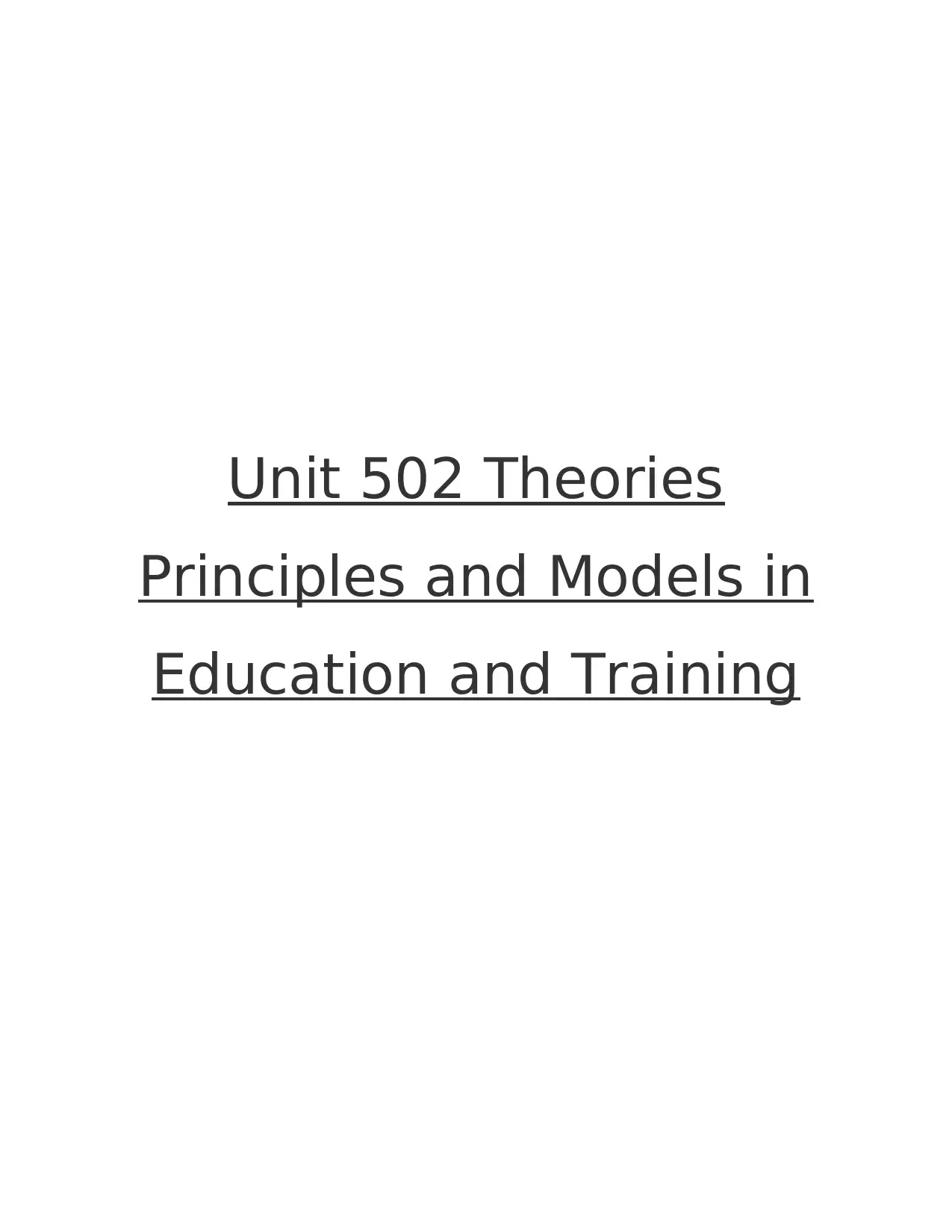
Unit 502 Theories
Principles and Models in
Education and Training
Principles and Models in
Education and Training
Paraphrase This Document
Need a fresh take? Get an instant paraphrase of this document with our AI Paraphraser
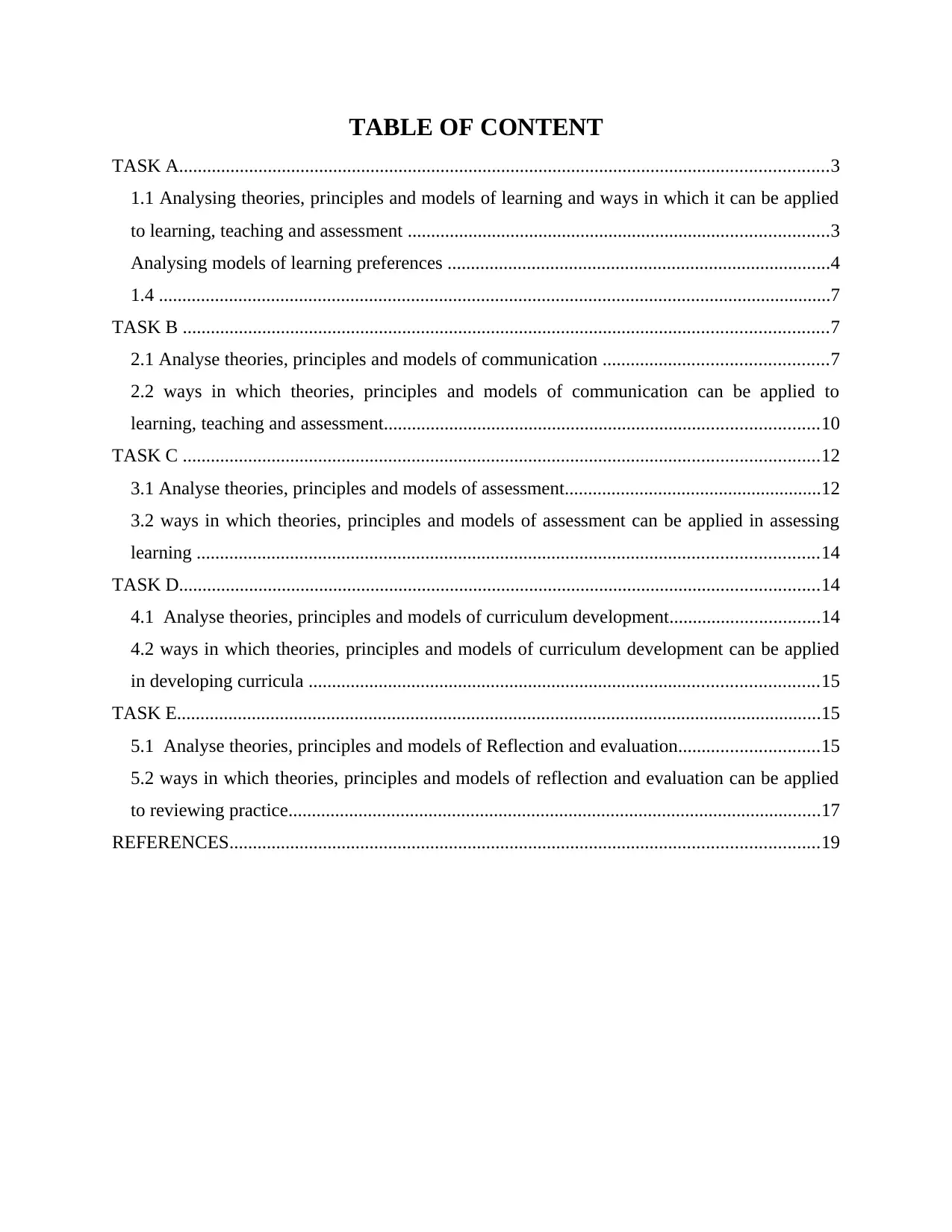
TABLE OF CONTENT
TASK A...........................................................................................................................................3
1.1 Analysing theories, principles and models of learning and ways in which it can be applied
to learning, teaching and assessment ..........................................................................................3
Analysing models of learning preferences ..................................................................................4
1.4 ................................................................................................................................................7
TASK B ..........................................................................................................................................7
2.1 Analyse theories, principles and models of communication ................................................7
2.2 ways in which theories, principles and models of communication can be applied to
learning, teaching and assessment.............................................................................................10
TASK C ........................................................................................................................................12
3.1 Analyse theories, principles and models of assessment.......................................................12
3.2 ways in which theories, principles and models of assessment can be applied in assessing
learning .....................................................................................................................................14
TASK D.........................................................................................................................................14
4.1 Analyse theories, principles and models of curriculum development................................14
4.2 ways in which theories, principles and models of curriculum development can be applied
in developing curricula .............................................................................................................15
TASK E..........................................................................................................................................15
5.1 Analyse theories, principles and models of Reflection and evaluation..............................15
5.2 ways in which theories, principles and models of reflection and evaluation can be applied
to reviewing practice..................................................................................................................17
REFERENCES..............................................................................................................................19
TASK A...........................................................................................................................................3
1.1 Analysing theories, principles and models of learning and ways in which it can be applied
to learning, teaching and assessment ..........................................................................................3
Analysing models of learning preferences ..................................................................................4
1.4 ................................................................................................................................................7
TASK B ..........................................................................................................................................7
2.1 Analyse theories, principles and models of communication ................................................7
2.2 ways in which theories, principles and models of communication can be applied to
learning, teaching and assessment.............................................................................................10
TASK C ........................................................................................................................................12
3.1 Analyse theories, principles and models of assessment.......................................................12
3.2 ways in which theories, principles and models of assessment can be applied in assessing
learning .....................................................................................................................................14
TASK D.........................................................................................................................................14
4.1 Analyse theories, principles and models of curriculum development................................14
4.2 ways in which theories, principles and models of curriculum development can be applied
in developing curricula .............................................................................................................15
TASK E..........................................................................................................................................15
5.1 Analyse theories, principles and models of Reflection and evaluation..............................15
5.2 ways in which theories, principles and models of reflection and evaluation can be applied
to reviewing practice..................................................................................................................17
REFERENCES..............................................................................................................................19
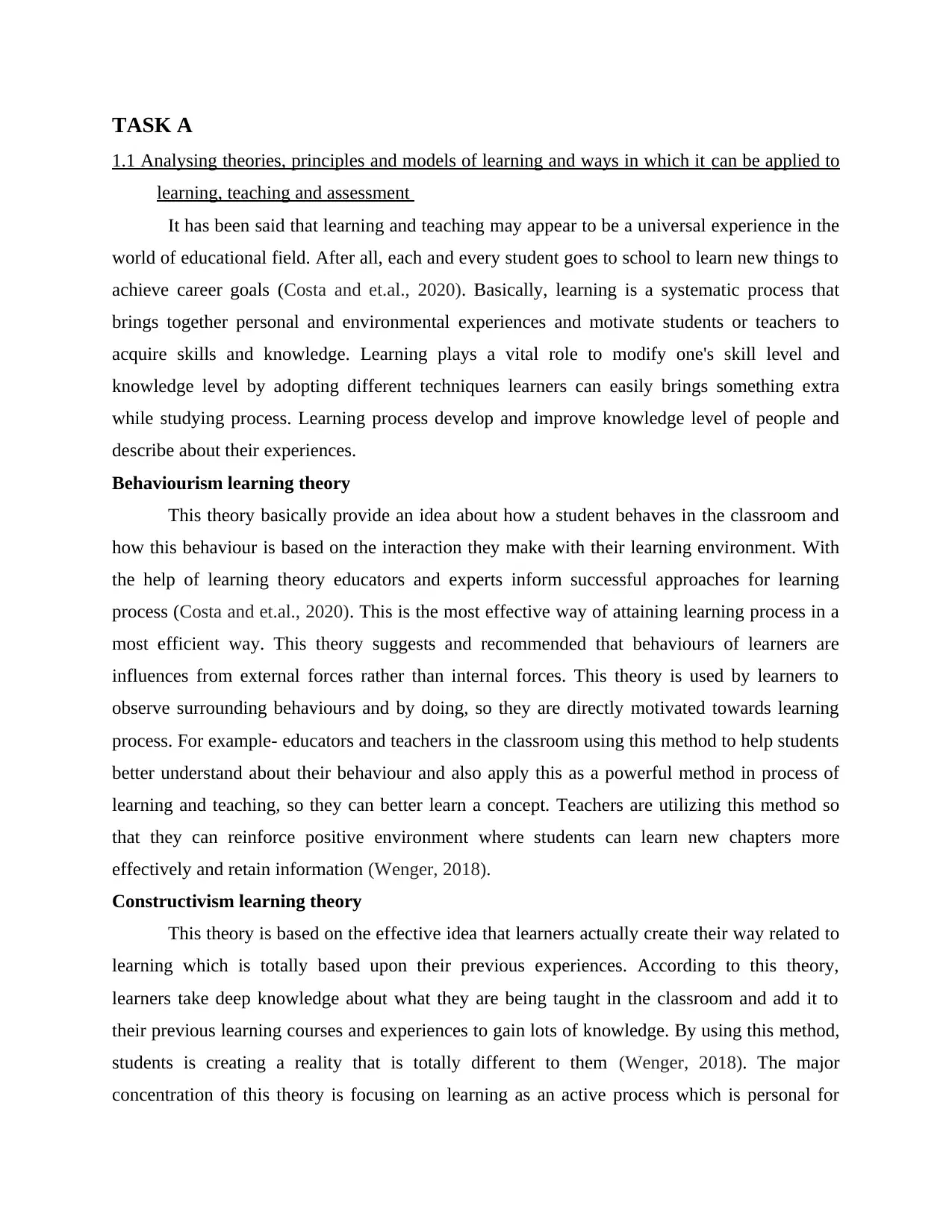
TASK A
1.1 Analysing theories, principles and models of learning and ways in which it can be applied to
learning, teaching and assessment
It has been said that learning and teaching may appear to be a universal experience in the
world of educational field. After all, each and every student goes to school to learn new things to
achieve career goals (Costa and et.al., 2020). Basically, learning is a systematic process that
brings together personal and environmental experiences and motivate students or teachers to
acquire skills and knowledge. Learning plays a vital role to modify one's skill level and
knowledge level by adopting different techniques learners can easily brings something extra
while studying process. Learning process develop and improve knowledge level of people and
describe about their experiences.
Behaviourism learning theory
This theory basically provide an idea about how a student behaves in the classroom and
how this behaviour is based on the interaction they make with their learning environment. With
the help of learning theory educators and experts inform successful approaches for learning
process (Costa and et.al., 2020). This is the most effective way of attaining learning process in a
most efficient way. This theory suggests and recommended that behaviours of learners are
influences from external forces rather than internal forces. This theory is used by learners to
observe surrounding behaviours and by doing, so they are directly motivated towards learning
process. For example- educators and teachers in the classroom using this method to help students
better understand about their behaviour and also apply this as a powerful method in process of
learning and teaching, so they can better learn a concept. Teachers are utilizing this method so
that they can reinforce positive environment where students can learn new chapters more
effectively and retain information (Wenger, 2018).
Constructivism learning theory
This theory is based on the effective idea that learners actually create their way related to
learning which is totally based upon their previous experiences. According to this theory,
learners take deep knowledge about what they are being taught in the classroom and add it to
their previous learning courses and experiences to gain lots of knowledge. By using this method,
students is creating a reality that is totally different to them (Wenger, 2018). The major
concentration of this theory is focusing on learning as an active process which is personal for
1.1 Analysing theories, principles and models of learning and ways in which it can be applied to
learning, teaching and assessment
It has been said that learning and teaching may appear to be a universal experience in the
world of educational field. After all, each and every student goes to school to learn new things to
achieve career goals (Costa and et.al., 2020). Basically, learning is a systematic process that
brings together personal and environmental experiences and motivate students or teachers to
acquire skills and knowledge. Learning plays a vital role to modify one's skill level and
knowledge level by adopting different techniques learners can easily brings something extra
while studying process. Learning process develop and improve knowledge level of people and
describe about their experiences.
Behaviourism learning theory
This theory basically provide an idea about how a student behaves in the classroom and
how this behaviour is based on the interaction they make with their learning environment. With
the help of learning theory educators and experts inform successful approaches for learning
process (Costa and et.al., 2020). This is the most effective way of attaining learning process in a
most efficient way. This theory suggests and recommended that behaviours of learners are
influences from external forces rather than internal forces. This theory is used by learners to
observe surrounding behaviours and by doing, so they are directly motivated towards learning
process. For example- educators and teachers in the classroom using this method to help students
better understand about their behaviour and also apply this as a powerful method in process of
learning and teaching, so they can better learn a concept. Teachers are utilizing this method so
that they can reinforce positive environment where students can learn new chapters more
effectively and retain information (Wenger, 2018).
Constructivism learning theory
This theory is based on the effective idea that learners actually create their way related to
learning which is totally based upon their previous experiences. According to this theory,
learners take deep knowledge about what they are being taught in the classroom and add it to
their previous learning courses and experiences to gain lots of knowledge. By using this method,
students is creating a reality that is totally different to them (Wenger, 2018). The major
concentration of this theory is focusing on learning as an active process which is personal for
⊘ This is a preview!⊘
Do you want full access?
Subscribe today to unlock all pages.

Trusted by 1+ million students worldwide
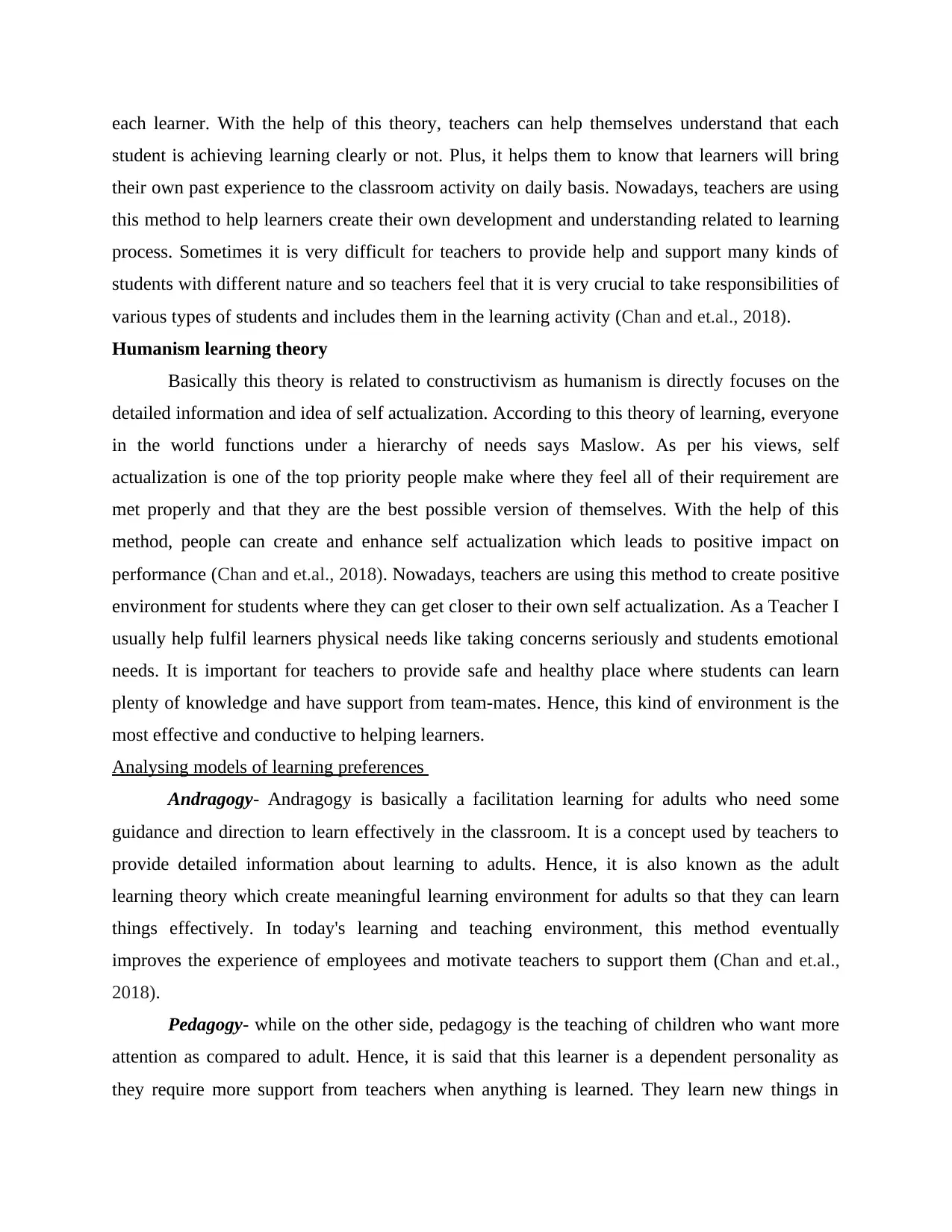
each learner. With the help of this theory, teachers can help themselves understand that each
student is achieving learning clearly or not. Plus, it helps them to know that learners will bring
their own past experience to the classroom activity on daily basis. Nowadays, teachers are using
this method to help learners create their own development and understanding related to learning
process. Sometimes it is very difficult for teachers to provide help and support many kinds of
students with different nature and so teachers feel that it is very crucial to take responsibilities of
various types of students and includes them in the learning activity (Chan and et.al., 2018).
Humanism learning theory
Basically this theory is related to constructivism as humanism is directly focuses on the
detailed information and idea of self actualization. According to this theory of learning, everyone
in the world functions under a hierarchy of needs says Maslow. As per his views, self
actualization is one of the top priority people make where they feel all of their requirement are
met properly and that they are the best possible version of themselves. With the help of this
method, people can create and enhance self actualization which leads to positive impact on
performance (Chan and et.al., 2018). Nowadays, teachers are using this method to create positive
environment for students where they can get closer to their own self actualization. As a Teacher I
usually help fulfil learners physical needs like taking concerns seriously and students emotional
needs. It is important for teachers to provide safe and healthy place where students can learn
plenty of knowledge and have support from team-mates. Hence, this kind of environment is the
most effective and conductive to helping learners.
Analysing models of learning preferences
Andragogy- Andragogy is basically a facilitation learning for adults who need some
guidance and direction to learn effectively in the classroom. It is a concept used by teachers to
provide detailed information about learning to adults. Hence, it is also known as the adult
learning theory which create meaningful learning environment for adults so that they can learn
things effectively. In today's learning and teaching environment, this method eventually
improves the experience of employees and motivate teachers to support them (Chan and et.al.,
2018).
Pedagogy- while on the other side, pedagogy is the teaching of children who want more
attention as compared to adult. Hence, it is said that this learner is a dependent personality as
they require more support from teachers when anything is learned. They learn new things in
student is achieving learning clearly or not. Plus, it helps them to know that learners will bring
their own past experience to the classroom activity on daily basis. Nowadays, teachers are using
this method to help learners create their own development and understanding related to learning
process. Sometimes it is very difficult for teachers to provide help and support many kinds of
students with different nature and so teachers feel that it is very crucial to take responsibilities of
various types of students and includes them in the learning activity (Chan and et.al., 2018).
Humanism learning theory
Basically this theory is related to constructivism as humanism is directly focuses on the
detailed information and idea of self actualization. According to this theory of learning, everyone
in the world functions under a hierarchy of needs says Maslow. As per his views, self
actualization is one of the top priority people make where they feel all of their requirement are
met properly and that they are the best possible version of themselves. With the help of this
method, people can create and enhance self actualization which leads to positive impact on
performance (Chan and et.al., 2018). Nowadays, teachers are using this method to create positive
environment for students where they can get closer to their own self actualization. As a Teacher I
usually help fulfil learners physical needs like taking concerns seriously and students emotional
needs. It is important for teachers to provide safe and healthy place where students can learn
plenty of knowledge and have support from team-mates. Hence, this kind of environment is the
most effective and conductive to helping learners.
Analysing models of learning preferences
Andragogy- Andragogy is basically a facilitation learning for adults who need some
guidance and direction to learn effectively in the classroom. It is a concept used by teachers to
provide detailed information about learning to adults. Hence, it is also known as the adult
learning theory which create meaningful learning environment for adults so that they can learn
things effectively. In today's learning and teaching environment, this method eventually
improves the experience of employees and motivate teachers to support them (Chan and et.al.,
2018).
Pedagogy- while on the other side, pedagogy is the teaching of children who want more
attention as compared to adult. Hence, it is said that this learner is a dependent personality as
they require more support from teachers when anything is learned. They learn new things in
Paraphrase This Document
Need a fresh take? Get an instant paraphrase of this document with our AI Paraphraser
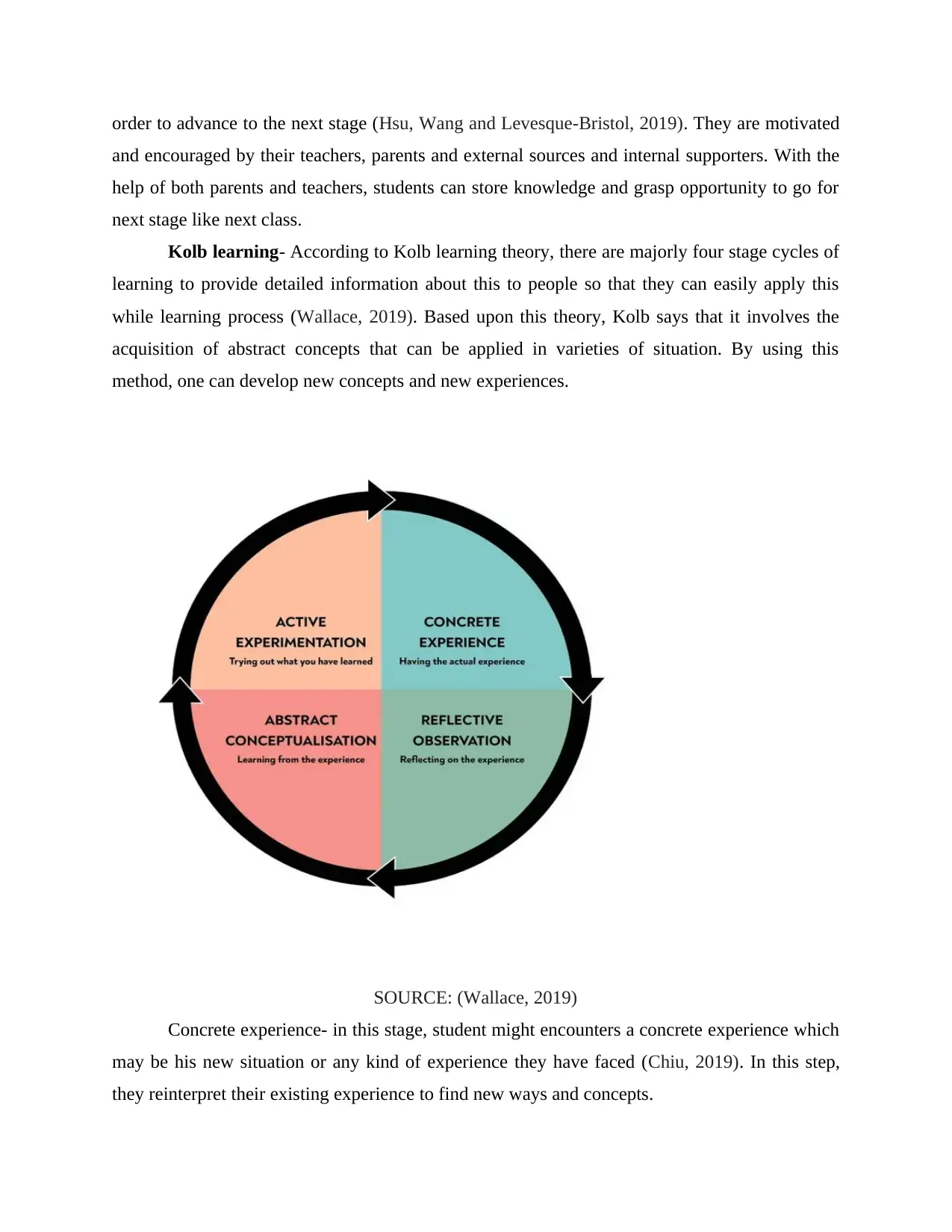
order to advance to the next stage (Hsu, Wang and Levesque-Bristol, 2019). They are motivated
and encouraged by their teachers, parents and external sources and internal supporters. With the
help of both parents and teachers, students can store knowledge and grasp opportunity to go for
next stage like next class.
Kolb learning- According to Kolb learning theory, there are majorly four stage cycles of
learning to provide detailed information about this to people so that they can easily apply this
while learning process (Wallace, 2019). Based upon this theory, Kolb says that it involves the
acquisition of abstract concepts that can be applied in varieties of situation. By using this
method, one can develop new concepts and new experiences.
SOURCE: (Wallace, 2019)
Concrete experience- in this stage, student might encounters a concrete experience which
may be his new situation or any kind of experience they have faced (Chiu, 2019). In this step,
they reinterpret their existing experience to find new ways and concepts.
and encouraged by their teachers, parents and external sources and internal supporters. With the
help of both parents and teachers, students can store knowledge and grasp opportunity to go for
next stage like next class.
Kolb learning- According to Kolb learning theory, there are majorly four stage cycles of
learning to provide detailed information about this to people so that they can easily apply this
while learning process (Wallace, 2019). Based upon this theory, Kolb says that it involves the
acquisition of abstract concepts that can be applied in varieties of situation. By using this
method, one can develop new concepts and new experiences.
SOURCE: (Wallace, 2019)
Concrete experience- in this stage, student might encounters a concrete experience which
may be his new situation or any kind of experience they have faced (Chiu, 2019). In this step,
they reinterpret their existing experience to find new ways and concepts.
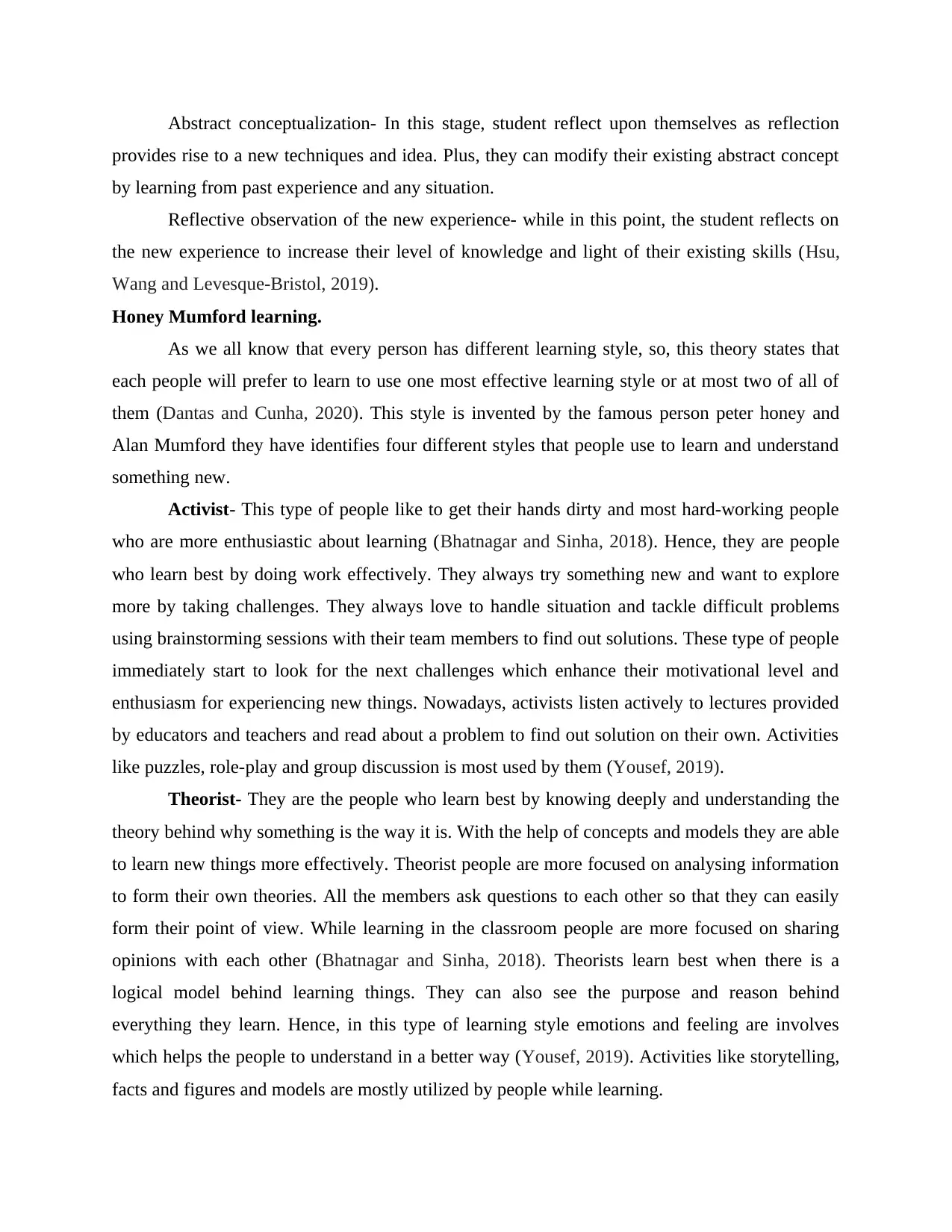
Abstract conceptualization- In this stage, student reflect upon themselves as reflection
provides rise to a new techniques and idea. Plus, they can modify their existing abstract concept
by learning from past experience and any situation.
Reflective observation of the new experience- while in this point, the student reflects on
the new experience to increase their level of knowledge and light of their existing skills (Hsu,
Wang and Levesque-Bristol, 2019).
Honey Mumford learning.
As we all know that every person has different learning style, so, this theory states that
each people will prefer to learn to use one most effective learning style or at most two of all of
them (Dantas and Cunha, 2020). This style is invented by the famous person peter honey and
Alan Mumford they have identifies four different styles that people use to learn and understand
something new.
Activist- This type of people like to get their hands dirty and most hard-working people
who are more enthusiastic about learning (Bhatnagar and Sinha, 2018). Hence, they are people
who learn best by doing work effectively. They always try something new and want to explore
more by taking challenges. They always love to handle situation and tackle difficult problems
using brainstorming sessions with their team members to find out solutions. These type of people
immediately start to look for the next challenges which enhance their motivational level and
enthusiasm for experiencing new things. Nowadays, activists listen actively to lectures provided
by educators and teachers and read about a problem to find out solution on their own. Activities
like puzzles, role-play and group discussion is most used by them (Yousef, 2019).
Theorist- They are the people who learn best by knowing deeply and understanding the
theory behind why something is the way it is. With the help of concepts and models they are able
to learn new things more effectively. Theorist people are more focused on analysing information
to form their own theories. All the members ask questions to each other so that they can easily
form their point of view. While learning in the classroom people are more focused on sharing
opinions with each other (Bhatnagar and Sinha, 2018). Theorists learn best when there is a
logical model behind learning things. They can also see the purpose and reason behind
everything they learn. Hence, in this type of learning style emotions and feeling are involves
which helps the people to understand in a better way (Yousef, 2019). Activities like storytelling,
facts and figures and models are mostly utilized by people while learning.
provides rise to a new techniques and idea. Plus, they can modify their existing abstract concept
by learning from past experience and any situation.
Reflective observation of the new experience- while in this point, the student reflects on
the new experience to increase their level of knowledge and light of their existing skills (Hsu,
Wang and Levesque-Bristol, 2019).
Honey Mumford learning.
As we all know that every person has different learning style, so, this theory states that
each people will prefer to learn to use one most effective learning style or at most two of all of
them (Dantas and Cunha, 2020). This style is invented by the famous person peter honey and
Alan Mumford they have identifies four different styles that people use to learn and understand
something new.
Activist- This type of people like to get their hands dirty and most hard-working people
who are more enthusiastic about learning (Bhatnagar and Sinha, 2018). Hence, they are people
who learn best by doing work effectively. They always try something new and want to explore
more by taking challenges. They always love to handle situation and tackle difficult problems
using brainstorming sessions with their team members to find out solutions. These type of people
immediately start to look for the next challenges which enhance their motivational level and
enthusiasm for experiencing new things. Nowadays, activists listen actively to lectures provided
by educators and teachers and read about a problem to find out solution on their own. Activities
like puzzles, role-play and group discussion is most used by them (Yousef, 2019).
Theorist- They are the people who learn best by knowing deeply and understanding the
theory behind why something is the way it is. With the help of concepts and models they are able
to learn new things more effectively. Theorist people are more focused on analysing information
to form their own theories. All the members ask questions to each other so that they can easily
form their point of view. While learning in the classroom people are more focused on sharing
opinions with each other (Bhatnagar and Sinha, 2018). Theorists learn best when there is a
logical model behind learning things. They can also see the purpose and reason behind
everything they learn. Hence, in this type of learning style emotions and feeling are involves
which helps the people to understand in a better way (Yousef, 2019). Activities like storytelling,
facts and figures and models are mostly utilized by people while learning.
⊘ This is a preview!⊘
Do you want full access?
Subscribe today to unlock all pages.

Trusted by 1+ million students worldwide
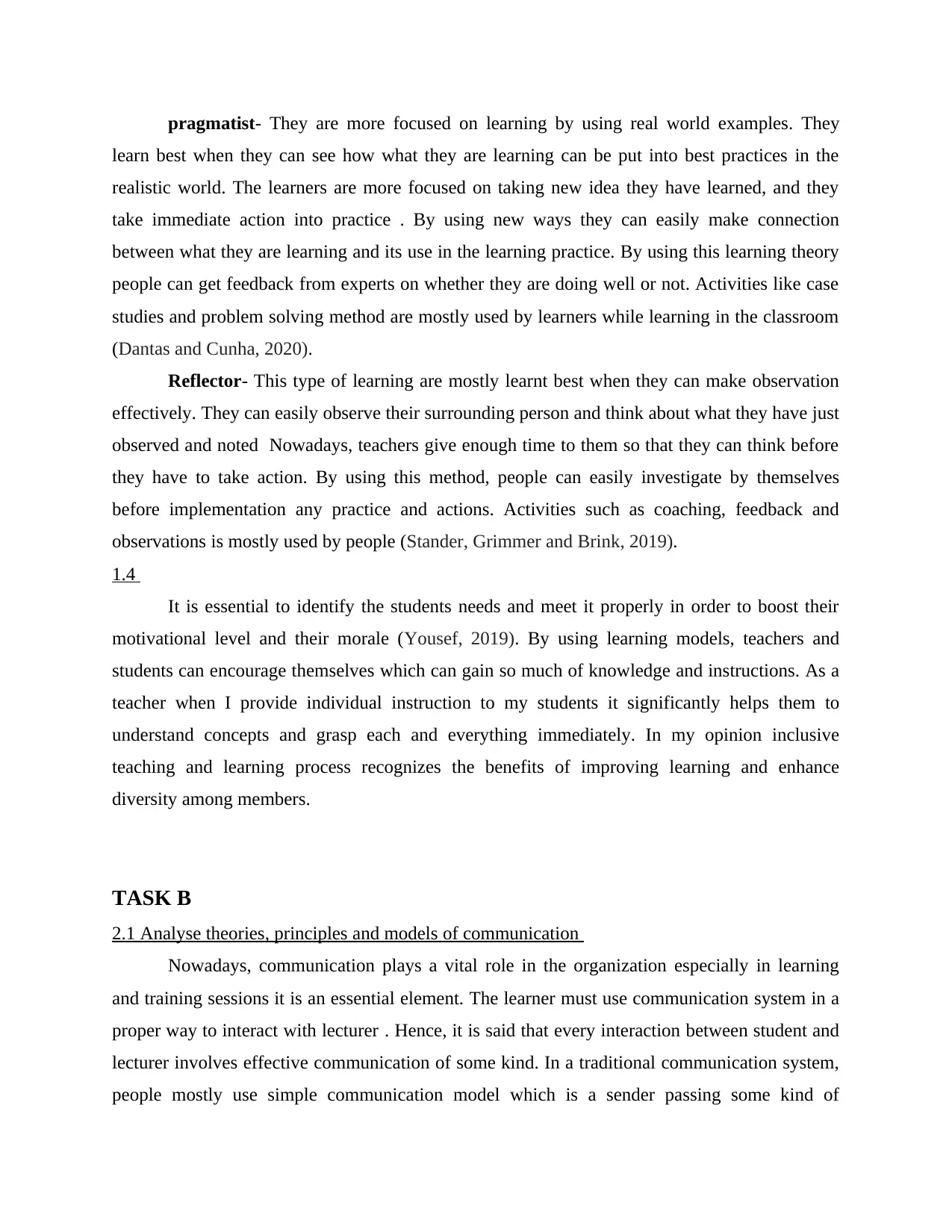
pragmatist- They are more focused on learning by using real world examples. They
learn best when they can see how what they are learning can be put into best practices in the
realistic world. The learners are more focused on taking new idea they have learned, and they
take immediate action into practice . By using new ways they can easily make connection
between what they are learning and its use in the learning practice. By using this learning theory
people can get feedback from experts on whether they are doing well or not. Activities like case
studies and problem solving method are mostly used by learners while learning in the classroom
(Dantas and Cunha, 2020).
Reflector- This type of learning are mostly learnt best when they can make observation
effectively. They can easily observe their surrounding person and think about what they have just
observed and noted Nowadays, teachers give enough time to them so that they can think before
they have to take action. By using this method, people can easily investigate by themselves
before implementation any practice and actions. Activities such as coaching, feedback and
observations is mostly used by people (Stander, Grimmer and Brink, 2019).
1.4
It is essential to identify the students needs and meet it properly in order to boost their
motivational level and their morale (Yousef, 2019). By using learning models, teachers and
students can encourage themselves which can gain so much of knowledge and instructions. As a
teacher when I provide individual instruction to my students it significantly helps them to
understand concepts and grasp each and everything immediately. In my opinion inclusive
teaching and learning process recognizes the benefits of improving learning and enhance
diversity among members.
TASK B
2.1 Analyse theories, principles and models of communication
Nowadays, communication plays a vital role in the organization especially in learning
and training sessions it is an essential element. The learner must use communication system in a
proper way to interact with lecturer . Hence, it is said that every interaction between student and
lecturer involves effective communication of some kind. In a traditional communication system,
people mostly use simple communication model which is a sender passing some kind of
learn best when they can see how what they are learning can be put into best practices in the
realistic world. The learners are more focused on taking new idea they have learned, and they
take immediate action into practice . By using new ways they can easily make connection
between what they are learning and its use in the learning practice. By using this learning theory
people can get feedback from experts on whether they are doing well or not. Activities like case
studies and problem solving method are mostly used by learners while learning in the classroom
(Dantas and Cunha, 2020).
Reflector- This type of learning are mostly learnt best when they can make observation
effectively. They can easily observe their surrounding person and think about what they have just
observed and noted Nowadays, teachers give enough time to them so that they can think before
they have to take action. By using this method, people can easily investigate by themselves
before implementation any practice and actions. Activities such as coaching, feedback and
observations is mostly used by people (Stander, Grimmer and Brink, 2019).
1.4
It is essential to identify the students needs and meet it properly in order to boost their
motivational level and their morale (Yousef, 2019). By using learning models, teachers and
students can encourage themselves which can gain so much of knowledge and instructions. As a
teacher when I provide individual instruction to my students it significantly helps them to
understand concepts and grasp each and everything immediately. In my opinion inclusive
teaching and learning process recognizes the benefits of improving learning and enhance
diversity among members.
TASK B
2.1 Analyse theories, principles and models of communication
Nowadays, communication plays a vital role in the organization especially in learning
and training sessions it is an essential element. The learner must use communication system in a
proper way to interact with lecturer . Hence, it is said that every interaction between student and
lecturer involves effective communication of some kind. In a traditional communication system,
people mostly use simple communication model which is a sender passing some kind of
Paraphrase This Document
Need a fresh take? Get an instant paraphrase of this document with our AI Paraphraser
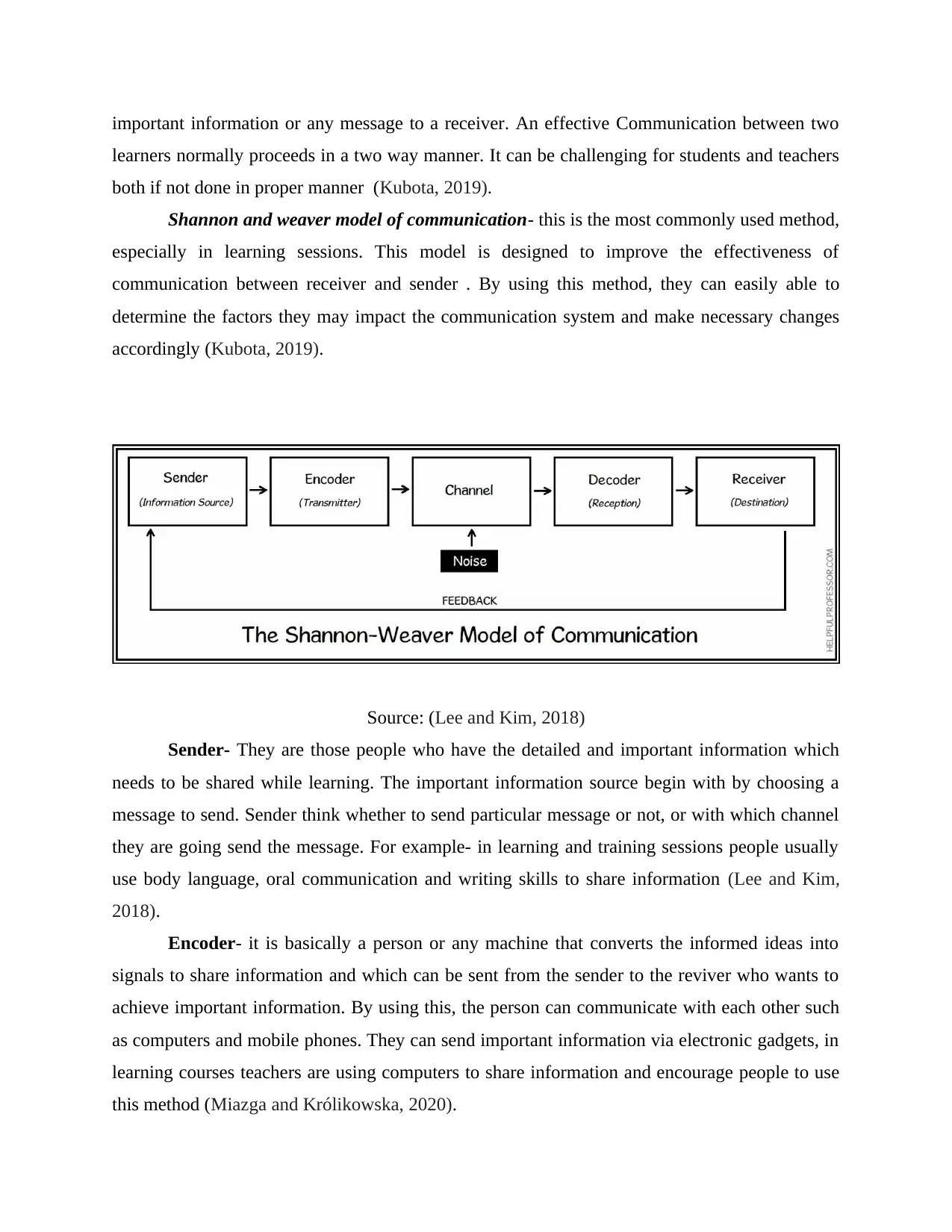
important information or any message to a receiver. An effective Communication between two
learners normally proceeds in a two way manner. It can be challenging for students and teachers
both if not done in proper manner (Kubota, 2019).
Shannon and weaver model of communication- this is the most commonly used method,
especially in learning sessions. This model is designed to improve the effectiveness of
communication between receiver and sender . By using this method, they can easily able to
determine the factors they may impact the communication system and make necessary changes
accordingly (Kubota, 2019).
Source: (Lee and Kim, 2018)
Sender- They are those people who have the detailed and important information which
needs to be shared while learning. The important information source begin with by choosing a
message to send. Sender think whether to send particular message or not, or with which channel
they are going send the message. For example- in learning and training sessions people usually
use body language, oral communication and writing skills to share information (Lee and Kim,
2018).
Encoder- it is basically a person or any machine that converts the informed ideas into
signals to share information and which can be sent from the sender to the reviver who wants to
achieve important information. By using this, the person can communicate with each other such
as computers and mobile phones. They can send important information via electronic gadgets, in
learning courses teachers are using computers to share information and encourage people to use
this method (Miazga and Królikowska, 2020).
learners normally proceeds in a two way manner. It can be challenging for students and teachers
both if not done in proper manner (Kubota, 2019).
Shannon and weaver model of communication- this is the most commonly used method,
especially in learning sessions. This model is designed to improve the effectiveness of
communication between receiver and sender . By using this method, they can easily able to
determine the factors they may impact the communication system and make necessary changes
accordingly (Kubota, 2019).
Source: (Lee and Kim, 2018)
Sender- They are those people who have the detailed and important information which
needs to be shared while learning. The important information source begin with by choosing a
message to send. Sender think whether to send particular message or not, or with which channel
they are going send the message. For example- in learning and training sessions people usually
use body language, oral communication and writing skills to share information (Lee and Kim,
2018).
Encoder- it is basically a person or any machine that converts the informed ideas into
signals to share information and which can be sent from the sender to the reviver who wants to
achieve important information. By using this, the person can communicate with each other such
as computers and mobile phones. They can send important information via electronic gadgets, in
learning courses teachers are using computers to share information and encourage people to use
this method (Miazga and Królikowska, 2020).
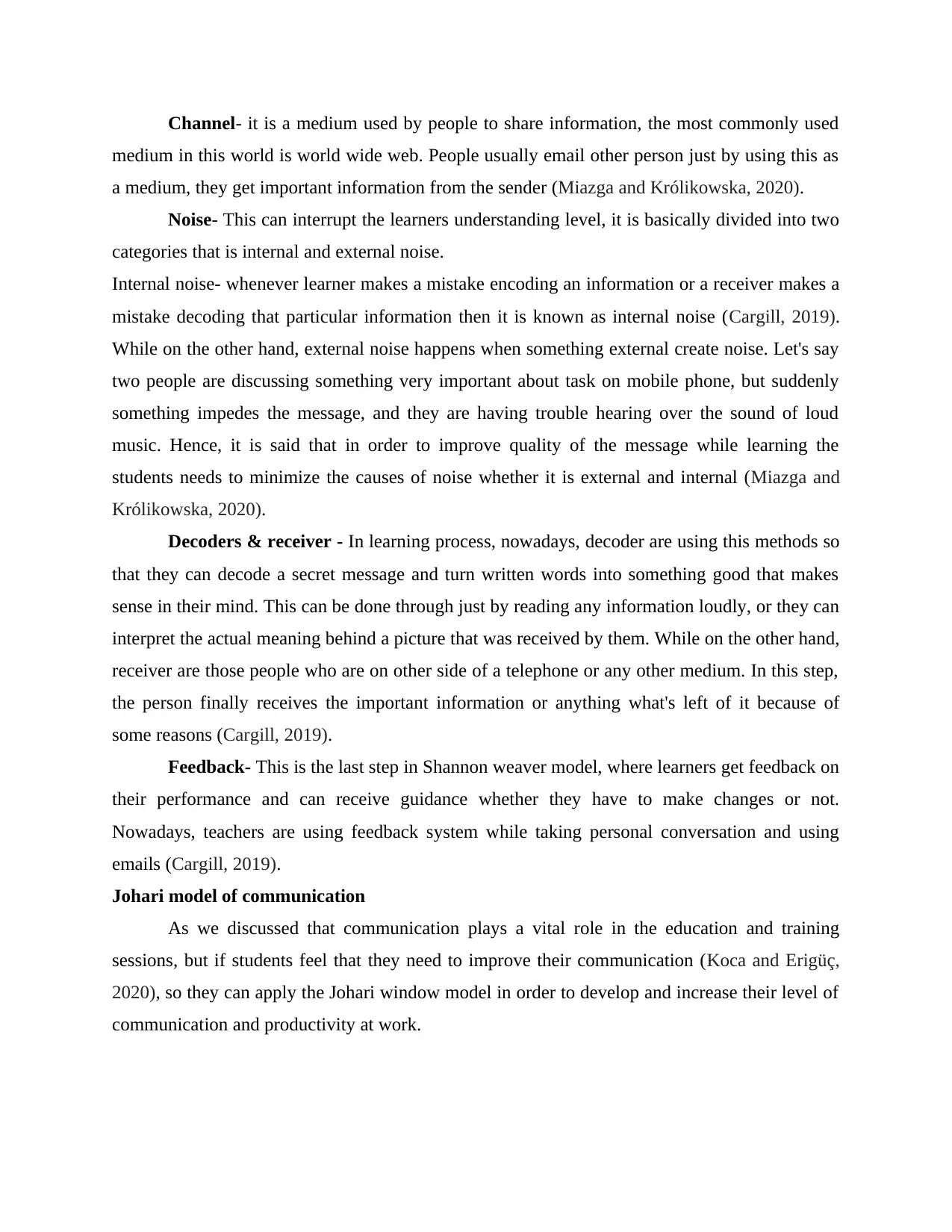
Channel- it is a medium used by people to share information, the most commonly used
medium in this world is world wide web. People usually email other person just by using this as
a medium, they get important information from the sender (Miazga and Królikowska, 2020).
Noise- This can interrupt the learners understanding level, it is basically divided into two
categories that is internal and external noise.
Internal noise- whenever learner makes a mistake encoding an information or a receiver makes a
mistake decoding that particular information then it is known as internal noise (Cargill, 2019).
While on the other hand, external noise happens when something external create noise. Let's say
two people are discussing something very important about task on mobile phone, but suddenly
something impedes the message, and they are having trouble hearing over the sound of loud
music. Hence, it is said that in order to improve quality of the message while learning the
students needs to minimize the causes of noise whether it is external and internal (Miazga and
Królikowska, 2020).
Decoders & receiver - In learning process, nowadays, decoder are using this methods so
that they can decode a secret message and turn written words into something good that makes
sense in their mind. This can be done through just by reading any information loudly, or they can
interpret the actual meaning behind a picture that was received by them. While on the other hand,
receiver are those people who are on other side of a telephone or any other medium. In this step,
the person finally receives the important information or anything what's left of it because of
some reasons (Cargill, 2019).
Feedback- This is the last step in Shannon weaver model, where learners get feedback on
their performance and can receive guidance whether they have to make changes or not.
Nowadays, teachers are using feedback system while taking personal conversation and using
emails (Cargill, 2019).
Johari model of communication
As we discussed that communication plays a vital role in the education and training
sessions, but if students feel that they need to improve their communication (Koca and Erigüç,
2020), so they can apply the Johari window model in order to develop and increase their level of
communication and productivity at work.
medium in this world is world wide web. People usually email other person just by using this as
a medium, they get important information from the sender (Miazga and Królikowska, 2020).
Noise- This can interrupt the learners understanding level, it is basically divided into two
categories that is internal and external noise.
Internal noise- whenever learner makes a mistake encoding an information or a receiver makes a
mistake decoding that particular information then it is known as internal noise (Cargill, 2019).
While on the other hand, external noise happens when something external create noise. Let's say
two people are discussing something very important about task on mobile phone, but suddenly
something impedes the message, and they are having trouble hearing over the sound of loud
music. Hence, it is said that in order to improve quality of the message while learning the
students needs to minimize the causes of noise whether it is external and internal (Miazga and
Królikowska, 2020).
Decoders & receiver - In learning process, nowadays, decoder are using this methods so
that they can decode a secret message and turn written words into something good that makes
sense in their mind. This can be done through just by reading any information loudly, or they can
interpret the actual meaning behind a picture that was received by them. While on the other hand,
receiver are those people who are on other side of a telephone or any other medium. In this step,
the person finally receives the important information or anything what's left of it because of
some reasons (Cargill, 2019).
Feedback- This is the last step in Shannon weaver model, where learners get feedback on
their performance and can receive guidance whether they have to make changes or not.
Nowadays, teachers are using feedback system while taking personal conversation and using
emails (Cargill, 2019).
Johari model of communication
As we discussed that communication plays a vital role in the education and training
sessions, but if students feel that they need to improve their communication (Koca and Erigüç,
2020), so they can apply the Johari window model in order to develop and increase their level of
communication and productivity at work.
⊘ This is a preview!⊘
Do you want full access?
Subscribe today to unlock all pages.

Trusted by 1+ million students worldwide
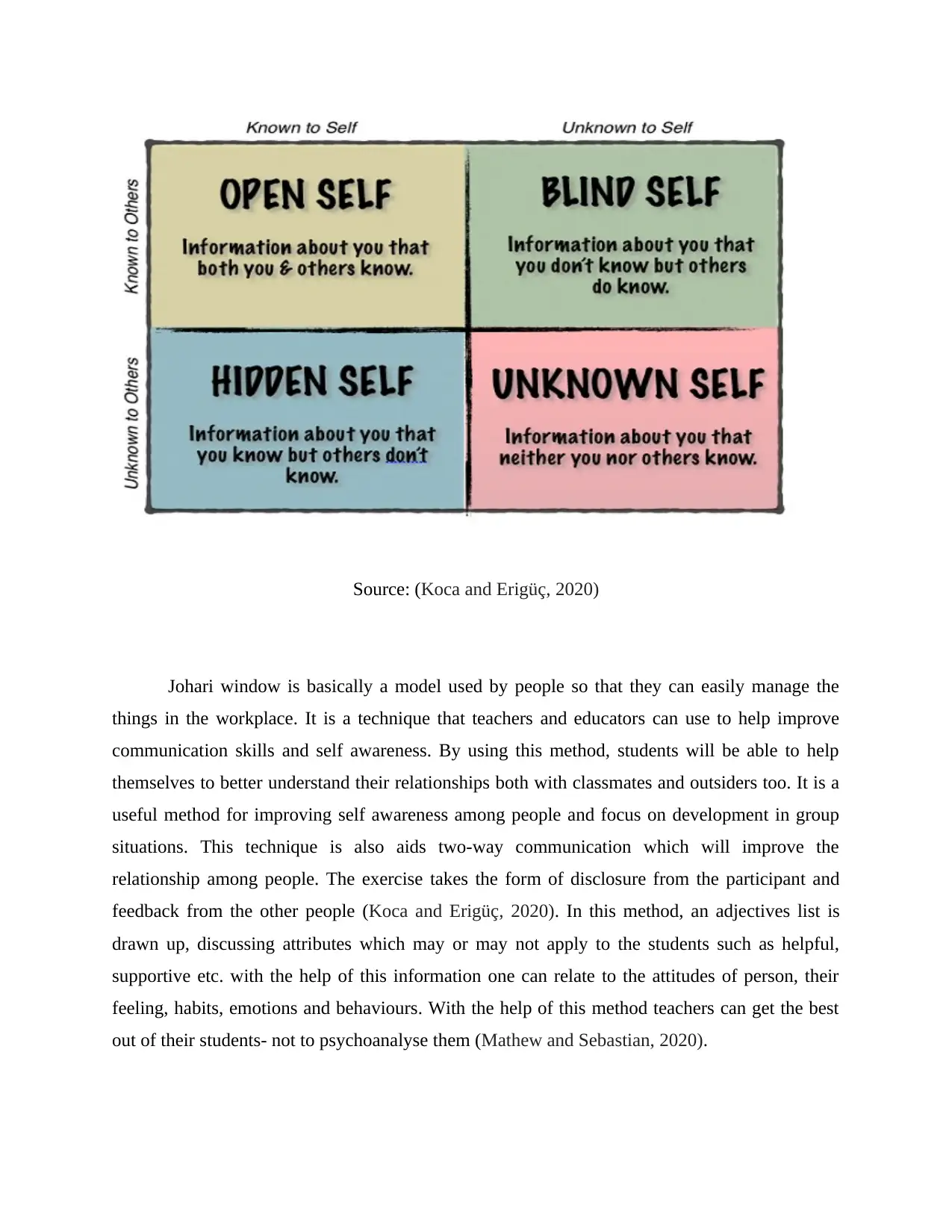
Source: (Koca and Erigüç, 2020)
Johari window is basically a model used by people so that they can easily manage the
things in the workplace. It is a technique that teachers and educators can use to help improve
communication skills and self awareness. By using this method, students will be able to help
themselves to better understand their relationships both with classmates and outsiders too. It is a
useful method for improving self awareness among people and focus on development in group
situations. This technique is also aids two-way communication which will improve the
relationship among people. The exercise takes the form of disclosure from the participant and
feedback from the other people (Koca and Erigüç, 2020). In this method, an adjectives list is
drawn up, discussing attributes which may or may not apply to the students such as helpful,
supportive etc. with the help of this information one can relate to the attitudes of person, their
feeling, habits, emotions and behaviours. With the help of this method teachers can get the best
out of their students- not to psychoanalyse them (Mathew and Sebastian, 2020).
Johari window is basically a model used by people so that they can easily manage the
things in the workplace. It is a technique that teachers and educators can use to help improve
communication skills and self awareness. By using this method, students will be able to help
themselves to better understand their relationships both with classmates and outsiders too. It is a
useful method for improving self awareness among people and focus on development in group
situations. This technique is also aids two-way communication which will improve the
relationship among people. The exercise takes the form of disclosure from the participant and
feedback from the other people (Koca and Erigüç, 2020). In this method, an adjectives list is
drawn up, discussing attributes which may or may not apply to the students such as helpful,
supportive etc. with the help of this information one can relate to the attitudes of person, their
feeling, habits, emotions and behaviours. With the help of this method teachers can get the best
out of their students- not to psychoanalyse them (Mathew and Sebastian, 2020).
Paraphrase This Document
Need a fresh take? Get an instant paraphrase of this document with our AI Paraphraser
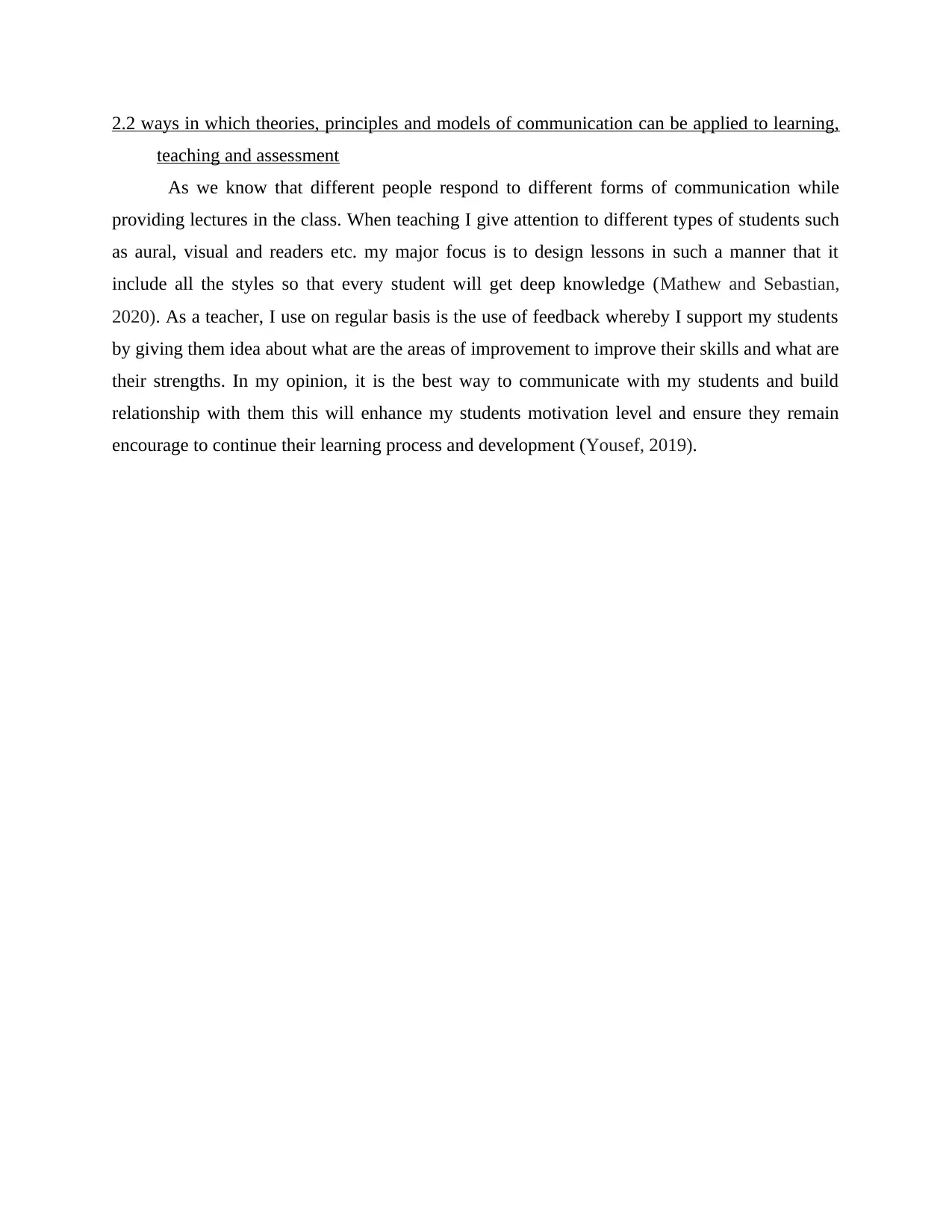
2.2 ways in which theories, principles and models of communication can be applied to learning,
teaching and assessment
As we know that different people respond to different forms of communication while
providing lectures in the class. When teaching I give attention to different types of students such
as aural, visual and readers etc. my major focus is to design lessons in such a manner that it
include all the styles so that every student will get deep knowledge (Mathew and Sebastian,
2020). As a teacher, I use on regular basis is the use of feedback whereby I support my students
by giving them idea about what are the areas of improvement to improve their skills and what are
their strengths. In my opinion, it is the best way to communicate with my students and build
relationship with them this will enhance my students motivation level and ensure they remain
encourage to continue their learning process and development (Yousef, 2019).
teaching and assessment
As we know that different people respond to different forms of communication while
providing lectures in the class. When teaching I give attention to different types of students such
as aural, visual and readers etc. my major focus is to design lessons in such a manner that it
include all the styles so that every student will get deep knowledge (Mathew and Sebastian,
2020). As a teacher, I use on regular basis is the use of feedback whereby I support my students
by giving them idea about what are the areas of improvement to improve their skills and what are
their strengths. In my opinion, it is the best way to communicate with my students and build
relationship with them this will enhance my students motivation level and ensure they remain
encourage to continue their learning process and development (Yousef, 2019).
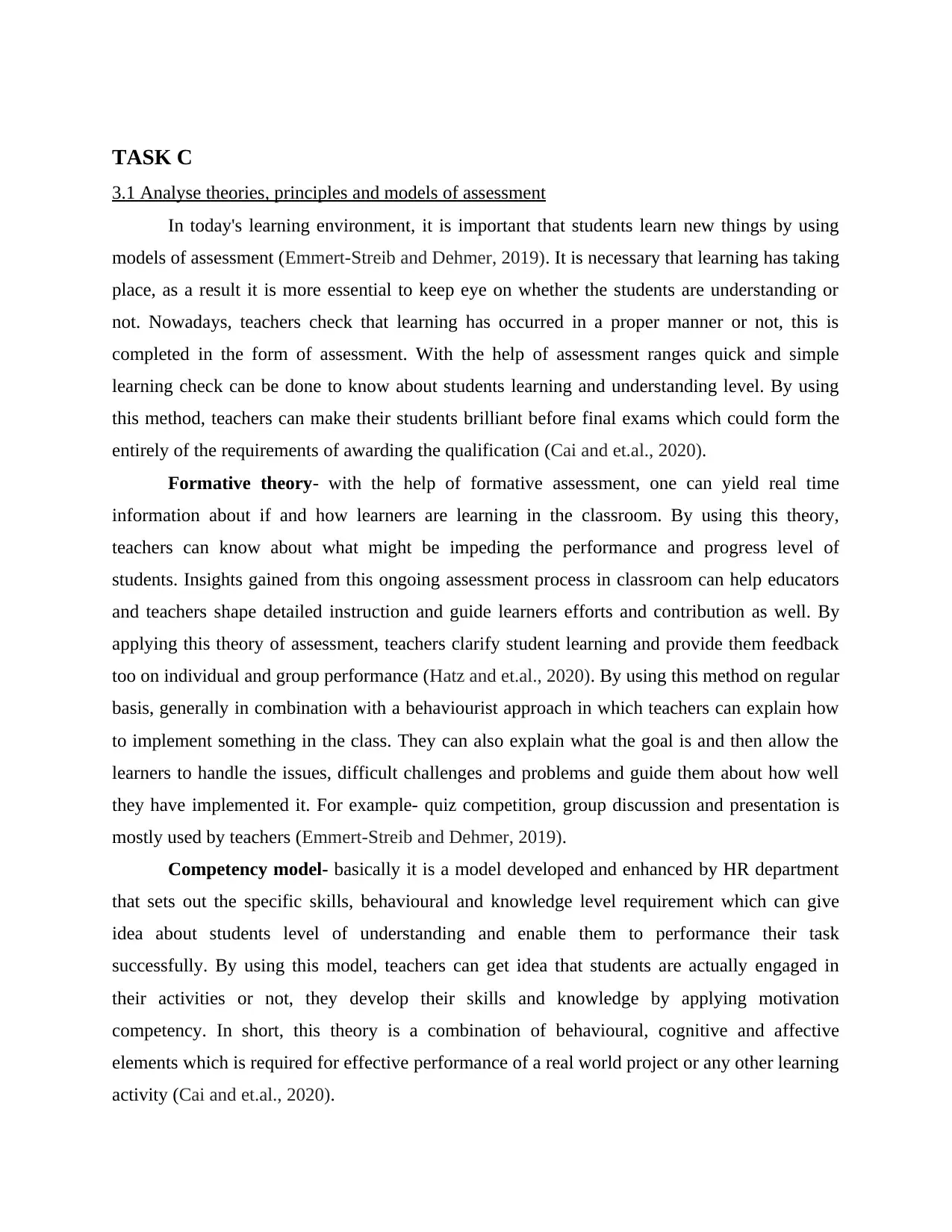
TASK C
3.1 Analyse theories, principles and models of assessment
In today's learning environment, it is important that students learn new things by using
models of assessment (Emmert-Streib and Dehmer, 2019). It is necessary that learning has taking
place, as a result it is more essential to keep eye on whether the students are understanding or
not. Nowadays, teachers check that learning has occurred in a proper manner or not, this is
completed in the form of assessment. With the help of assessment ranges quick and simple
learning check can be done to know about students learning and understanding level. By using
this method, teachers can make their students brilliant before final exams which could form the
entirely of the requirements of awarding the qualification (Cai and et.al., 2020).
Formative theory- with the help of formative assessment, one can yield real time
information about if and how learners are learning in the classroom. By using this theory,
teachers can know about what might be impeding the performance and progress level of
students. Insights gained from this ongoing assessment process in classroom can help educators
and teachers shape detailed instruction and guide learners efforts and contribution as well. By
applying this theory of assessment, teachers clarify student learning and provide them feedback
too on individual and group performance (Hatz and et.al., 2020). By using this method on regular
basis, generally in combination with a behaviourist approach in which teachers can explain how
to implement something in the class. They can also explain what the goal is and then allow the
learners to handle the issues, difficult challenges and problems and guide them about how well
they have implemented it. For example- quiz competition, group discussion and presentation is
mostly used by teachers (Emmert-Streib and Dehmer, 2019).
Competency model- basically it is a model developed and enhanced by HR department
that sets out the specific skills, behavioural and knowledge level requirement which can give
idea about students level of understanding and enable them to performance their task
successfully. By using this model, teachers can get idea that students are actually engaged in
their activities or not, they develop their skills and knowledge by applying motivation
competency. In short, this theory is a combination of behavioural, cognitive and affective
elements which is required for effective performance of a real world project or any other learning
activity (Cai and et.al., 2020).
3.1 Analyse theories, principles and models of assessment
In today's learning environment, it is important that students learn new things by using
models of assessment (Emmert-Streib and Dehmer, 2019). It is necessary that learning has taking
place, as a result it is more essential to keep eye on whether the students are understanding or
not. Nowadays, teachers check that learning has occurred in a proper manner or not, this is
completed in the form of assessment. With the help of assessment ranges quick and simple
learning check can be done to know about students learning and understanding level. By using
this method, teachers can make their students brilliant before final exams which could form the
entirely of the requirements of awarding the qualification (Cai and et.al., 2020).
Formative theory- with the help of formative assessment, one can yield real time
information about if and how learners are learning in the classroom. By using this theory,
teachers can know about what might be impeding the performance and progress level of
students. Insights gained from this ongoing assessment process in classroom can help educators
and teachers shape detailed instruction and guide learners efforts and contribution as well. By
applying this theory of assessment, teachers clarify student learning and provide them feedback
too on individual and group performance (Hatz and et.al., 2020). By using this method on regular
basis, generally in combination with a behaviourist approach in which teachers can explain how
to implement something in the class. They can also explain what the goal is and then allow the
learners to handle the issues, difficult challenges and problems and guide them about how well
they have implemented it. For example- quiz competition, group discussion and presentation is
mostly used by teachers (Emmert-Streib and Dehmer, 2019).
Competency model- basically it is a model developed and enhanced by HR department
that sets out the specific skills, behavioural and knowledge level requirement which can give
idea about students level of understanding and enable them to performance their task
successfully. By using this model, teachers can get idea that students are actually engaged in
their activities or not, they develop their skills and knowledge by applying motivation
competency. In short, this theory is a combination of behavioural, cognitive and affective
elements which is required for effective performance of a real world project or any other learning
activity (Cai and et.al., 2020).
⊘ This is a preview!⊘
Do you want full access?
Subscribe today to unlock all pages.

Trusted by 1+ million students worldwide
1 out of 21
Related Documents
Your All-in-One AI-Powered Toolkit for Academic Success.
+13062052269
info@desklib.com
Available 24*7 on WhatsApp / Email
![[object Object]](/_next/static/media/star-bottom.7253800d.svg)
Unlock your academic potential
Copyright © 2020–2025 A2Z Services. All Rights Reserved. Developed and managed by ZUCOL.
